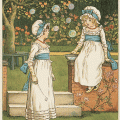Serving Our Nation’s Veterans
Kent Wang, docent at the National Air and Space Museum, shares a few thoughts about the museum, the visitors and the dedication of the volunteers and staff, so our colleagues can get a sense of what an exhilarating experience it can be to connect a veteran with the past.

Kent Wang, right, recently provided a guided tour of the Air and Space Museum for a group of Tri-City Woorld War II veterans (seated) and their volunteer companions (in green shirts) as part of the Honor Flight Veterans program. Photo courtesy of Kent Wang
I fell in love with both aviation and the Smithsonian Institution when I moved to Washington, D. C., in 1995. I was attracted to the National Air and Space Museum years ago and decided that I could best contribute to the future of aviation by joining the volunteer corps. In 1997, I began working as an Information Specialist at NASM. The Information Desk is a focal point at all our museums and Information Specialists serve as the personal face of the Smithsonian for visitors.
When the Steven F. Udvar-Hazy Center recruited docents prior to its public opening in May 2003, I applied and went through initial training combining six months of classroom and “in-the-museum” instruction along with a six-month apprenticeship with an experienced docent. In 2004, I also went through a rigorous 13 weeks of training on the Mall museum’s artifacts, galleries, and research areas as well as on techniques for conducting effective tours. The best part of the docent program for me is working with the always-willing and enthusiastic museum research staff and opening up the eyes of visitors to the positive and interesting experiences museums have to offer. It’s always illuminating and gratifying when I realize I have caught someone’s attention.
Although every exhibit in the Air and Space museum is impressive, the most impressive part of this complex operation has to be the dedication of the volunteers and the museum staff. Our volunteer docents are inspired by the museum. Some of our volunteers painstakingly restore and clean planes, and check the detail and history of every artifact. Others answer questions, direct families to the sights and talk to the visitors. Many of our volunteers are veterans or relatives of veterans. All are devoted to the community and out mission.
Visitors from around the world come to see air and spacecraft, including our unique selection of warplanes and vintage aircraft. As a volunteer, there is nothing more rewarding for me than to help an Honor Flight Veteran locate a plane he or she flew, traveled in or maintained. The Honor Flight Network is a non-profit organization that honors veterans by transporting them to Washington, D.C. to visit and reflect at their memorials. Top priority is given to the senior veterans – World War II survivors, along with those other veterans who may be terminally ill. Fewer and fewer Honor Flight Veterans are making the trip these days as they are becoming frail from aging. We are always happy to see Honor Flight veterans and grateful to talk to them. For many of us at the museum, these WW II veterans are legends.

Kent Wang, left, discusses the Enola Gay exhibition with visiting WWII veterans during a special Honor Veterans tour. The Enola Gay, a Boeing B-29 Superfortress bomber, was the first aircraft to drop an atomic bomb. (Photo courtesy Kent Wang)
As a veteran myself, I’m proud to have an opportunity to be affiliated with NASM and to have served the Honor Flight veterans with more than 50 tours at both the National Mall Building and the Udvar-Hazy Center. I have learned a lot over the years and one point that stands out is that our Honor Flight veteran heroes aren’t asking for recognition. It is my position that they deserve it. The NASM program is just a small token of our appreciation for those that gave so much.
The members of what Tom Brokaw called “The Greatest Generation” are our fathers, mothers and grandparents. Their stories come to life when the Honor Veterans visit our museums; without their sacrifice, the aircraft and artifacts on display would be simply inanimate objects.
Due to the senior age of these veterans, and the prediction that we are losing approximately 640 of them daily, I am committed to do all within my realm to serve the Honor Flight WW II veterans and all those who share their spirit and love of flight. I think I can speak for all of the docents who have participated in the Honor Flight Program when I say the experience is exhilarating and one that will remain with us for the rest of our lives. My heartfelt thanks to Honor Flight Network for the opportunity they gave us to honor their service and sacrifice.
Kent Wang has been a volunteer docent at the Air and Space Museum since 1997.
Posted: 3 May 2018
-
Categories:
Air and Space Museum , Education, Access & Outreach , History and Culture , Volunteer Voices






